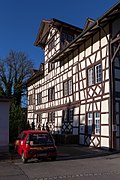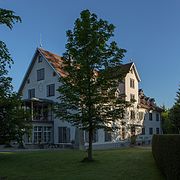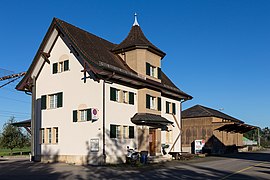Hauptwil
| Hauptwil | ||
|---|---|---|
| State : |
|
|
| Canton : |
|
|
| District : | Weinfelden | |
| Political community : | Hauptwil-Gottshaus | |
| Postal code : | 9213 | |
| former BFS no. : | 4487 | |
| Coordinates : | 736 708 / 260 494 | |
| Height : | 540 m above sea level M. | |
| Area : | 3.11 km² (local parish ) 12.49 km² (municipality) |
|
| Residents: | 1213 (December 31, 2018) | |
| Population density : | 390 inhabitants per km² | |
|
Gate tower with contemporary clockwork |
||
| map | ||
|
|
||
Hauptwil is a village and a former local and municipal municipality in the canton of Thurgau in Switzerland . The local community of Hauptwil, located southeast of Bischofszell , and the local community of Gottshaus formed the municipal community of Hauptwil from 1812 to 1995 and has been part of the political community of Hauptwil-Gottshaus since January 1, 1996 .
history
Hauptwil was first mentioned in 1413 as Hoptwill . In the late Middle Ages Hauptwil was part of the small jurisdiction of Blidegg , to which Zihlschlacht and Degenau also belonged. From 1377 at the latest, Blidegg belonged as a fief to the bishop of Constance and the prince abbey of St. Gallen the noble Ryff, known as Welter von Blidegg, and from 1561 to the barons of Hallwyl . A special place was the hamlet of free shepherd who own a small low-judicial district belonged to the lords of Andwil and Blarer of Wartensee was and in 1654 came through purchase to the family Gonzenbach. As a former feudal territory of the Prince Abbey of St. Gallen Freihirten had a predominantly Catholic population.
Pointing the way for the later development of Hauptwil was that the Canon Monastery of St. Pelagius in Bischofszell had five carp ponds built in the valley between Hauptwil and Wilen around 1430 , thus creating the prerequisites for the later use of hydropower and thus the industrialization of Hauptwil.
Formative for the further development of the village in the 17th and 18th centuries was the Clothier family Gonzenbach that the patrician belonged to upper class and because of the innovation sfeindlichen structure of St. Gall moved linen industry to Hauptwil. The family, which owned several properties in Hauptwil before 1600, held the Hauptwil Lower Court from 1664 to 1798 . After the arrival of the Gonzenbach, the farming village developed into a manufacturing settlement characterized by linen production . In addition to lower wages, hydropower and economic freedom were conducive to industrialization. In 1664 Hauptwil received market rights . The castle was built in 1664/1665 and served as a retirement home from 1952 onwards and in 2020 it came into private ownership. 1661-71 in were Stampflehmverfahren around forty new manufacturing and Arbeiterwohnbauten built, which was a unique event in eastern Switzerland's industrial history. In January 1801 Friedrich Hölderlin joined the Gonzenbach family as a private tutor.
At the end of the 18th century, the brothers Enoch and Johann Joachim Brunschweiler from Erlen settled in Hauptwil. After the stagnation in linen production, they built up the dyeing industry in the village. Together with Hans Jacob Gonzenbach (1754–1815), they drove the liberation of Thurgau from federal subjects .

In the course of industrialization , embroidery and weaving also gained a foothold, as well as the Staub & Honegger cotton spinning mill in the nearby Sorntal in the municipality of Waldkirch SG in 1923 . The opening of the Sulgen – Gossau railway line in 1876 ensured continued economic prosperity. In addition to the textile industry , agriculture has always remained an important branch of the economy in Hauptwil. Towards the end of the 19th century the transition from viticulture and agriculture to cattle and dairy farming took place. The dairy was established in 1909. Since the Brunschweiler family's dye works ceased operations in 1984, only Zetag AG with the former spinning mill in Sorntal still bears witness to the former textile production. With the construction of single-family houses, the migration that occurred in the 1970s after 1980 was stopped. The well-preserved old buildings and the now converted industrial cultural landscape from the 17th to 19th centuries still characterize the townscape. Hauptwil was awarded the Wakker Prize in 1999 .
The Catholic part of the population has always belonged to the Bischofszell parish. From 1667 church services for the Reformed population took place in the Gonzenbach castle chapel, and in 1861 the Reformed parish became a branch of Bischofszell. In 1886 a reformed church was built, and in 1967/68 the Catholic Church of St. Antonius . Starting with the industrial family Brunschweiler, a community of Protestant baptismal people was formed in Hauptwil in the early 19th century , to which 10% of the population belonged in 1880. The Free Evangelical Congregation is still represented in Hauptwil today .
1996 merged the local churches Hauptwil and Gottshaus - the latter without the districts halt and width for unified community Bischofszell came - the political community Hauptwil-Gottshaus.
coat of arms
Blazon : In red a three-part white gate tower with black roofs
The gate tower is one of the characteristic architectural monuments of Hauptwil.
population
| 1649 | 1850 | 1900 | 1950 | 1990 | 2000 | 2010 | 2018 | |
|---|---|---|---|---|---|---|---|---|
| Municipal parish | 1379 | 1417 | 1617 | 1721 | ||||
| Local parish | approx. 50 | 598 | 741 | 819 | 910 | |||
| Locality | 522 | 457 | 1213 | |||||
| source | ||||||||
Of the total of 1213 inhabitants of the village of Hauptwil in 2018, 122 or 10.1% were foreign nationals. 433 (35.7%) were Roman Catholic and 406 (33.5%) Protestant Reformed.
traffic
Hauptwil is accessed by the main road Gossau SG –Bischofzell and has a train station on the Gossau – Sulgen line .
Personalities
- Stefan «Steve» Blaser (* 1972), musician, singer, DJ and producer
- Arthur Dürst (1926–2000), geographer and map historian
- Fritz Honegger (1917–1999), politician
- Albert Schoop (1919–1998), art and literary historian
- Lukas Speissegger (* 1969), musician, producer, sound engineer
Attractions
In Hauptwil, residential and commercial buildings from the middle of the 17th century, when the Gonzenbach merchant family transformed the village into a center for canvas production with the associated infrastructure such as bleaching plants, ponds and warehouses, could be preserved and given new uses. Hauptwil is listed in the inventory of places worthy of protection in Switzerland .
More pictures
Web links
Individual evidence
- ↑ Swiss land use statistics. Completed on July 1, 1912. Published by the Federal Statistical Bureau. ( Memento from April 12, 2016 in the Internet Archive )
- ↑ Thurgau in figures 2019 . On the website of the Statistical Office of the Canton of Thurgau (PDF file; 1.8 MB), accessed on April 28, 2020.
- ↑ a b c d Localities and their resident population. Edition 2019 . On the website of the Statistical Office of the Canton of Thurgau (Excel table; 0.1 MB), accessed on April 28, 2020.
-
↑ a b c d e f g h i Verena Rothenbühler: Hauptwil. In: Historical Lexicon of Switzerland .
These sections are largely based on the entry in the Historical Lexicon of Switzerland (HLS), which, according to the HLS's usage information, is under the Creative Commons license - Attribution - Share under the same conditions 4.0 International (CC BY-SA 4.0). - ↑ a b c d e f g Ernest Menolfi: The story of Hauptwil-Gottshaus, on the website of the municipality of Hauptwil-Gottshaus, May 2012
- ↑ Georg Stelzner: A German count buys Hauptwil Castle - no chance for the local cooperative. St. Galler Tagblatt , March 27, 2020.
- ^ Antonius Church Hauptwil. On the website of the pastoral area Bischofsberg, accessed on November 22, 2019.
- ↑ Population development of the municipalities. Canton of Thurgau, 1850-2000. On the website of the Statistical Office of the Canton of Thurgau (Excel table; 0.1 MB), accessed on April 28, 2020.
- ↑ a b municipal coat of arms . On the website of the State Archives of the Canton of Thurgau, accessed on December 8, 2019
- ↑ Locations and Settlements Directory. Canton of Thurgau, 2005 edition . On the website of the Statistical Office of the Canton of Thurgau (PDF; 1.7 MB), accessed on April 28, 2020.
- ↑ Locations and Settlements Directory. Canton of Thurgau, 2012 edition. On the website of the Statistical Office of the Canton of Thurgau (PDF; 3.4 MB), accessed on May 11, 2020.
- ↑ The previous Wakker prices. From the Swiss Homeland Security website , accessed on April 18, 2020
Remarks
- ↑ with outside courtyards




















